
Concept explainers
a)
To determine:The probability of completing the project in 17 months.
Introduction:
The activity times of various tasks in a PERT project network are assumed to follow a probability distribution. For calculating the expected times and standard deviation, the parameters required are the following:
- Optimistic time: This is the time denoted by “a”, which is the best possible or in other words, the quickest time in which an activity can be completed, assuming that everything goes as per plan.
- Pessimistic time: This is the worst case scenario, where all the conditions are adverse or unfavorable. The maximum time which may be taken in such a situation is the pessimistic time denoted by “b”.
- Most likely time: The most realistic estimate of the time, denoted by “m” in normal conditions, is another parameter which is important in the computation of expected times and variances.
a)
Answer to Problem 23P
The probability that the project completion time is 17 months is 0.0228.
Explanation of Solution
Given information:
Calculation of probability of completing the project in 17 months:
The standard deviationis
Z is calculated by dividing the difference of 17 and 21 with 2 which gives -2. From the
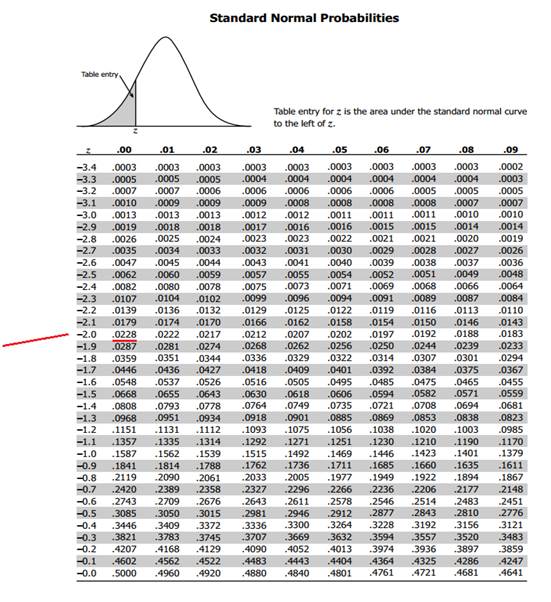
Hence, the probability that the project completion time is 17 months is 0.0228.
b)
To determine:The probability of completing the project in 20 months.
b)
Answer to Problem 23P
The probability that the project completion time is 20 months is 0.3085.
Explanation of Solution
Given information:
Calculation of probability of completing the project in 20 months:
Calculate the standard deviation
Z is calculated by dividing the difference of 21 and 20 with 2 which gives -0.5. From the normal distribution tables z value -0.5 corresponds to 0.3085.
Use the normal distribution tables to calculate the probability
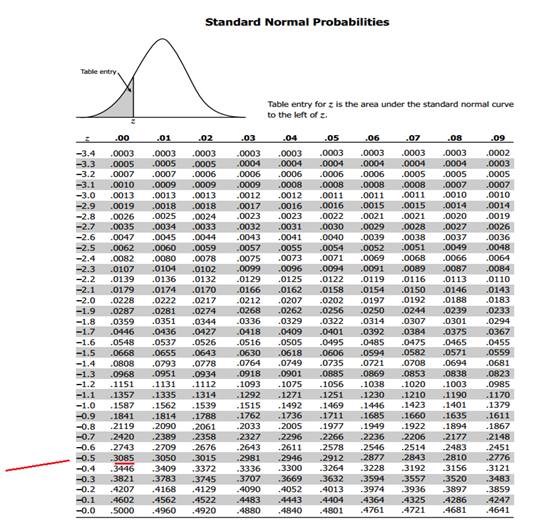
The probability of project completion in 20 months is 0.3085.
Hence, the probability that the project completion time is 20 months is 0.3085.
c)
To determine:The probability of completing the project in 23 months.
c)
Answer to Problem 23P
The probability that the project completion time is 23 months is 0.8413.
Explanation of Solution
Given information:
Calculation of probability of completing the project in 23 months:
Calculate the standard deviation
Z is calculated by dividing the difference of 23 and 21 with 2 which gives 1. From the normal distribution tables z value 1 corresponds to 0.8413.
Use the normal distribution tables to calculate the probability
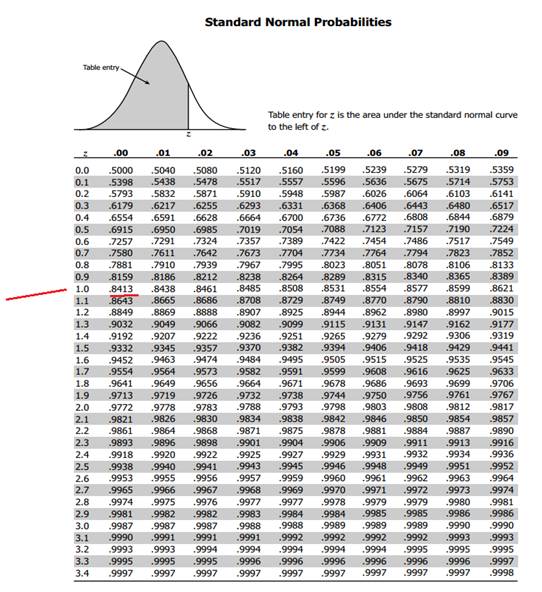
The probability of project completion in 23 months is 0.8413.
Hence, the probability that the project completion time is 23 months is 0.8413.
d)
To determine:The probability of completing the project in 25 months.
d)
Answer to Problem 23P
The probability that the project completion time is 25 months is 0.9772.
Explanation of Solution
Given information:
Calculation of probability of completing the project in 25 months:
Calculate the standard deviation
Z is calculated by dividing the difference of 25 and 21 with 2 which gives 2. From the normal distribution tables z value 2 corresponds to 0.9772.
Use the normal distribution tables to calculate the probability
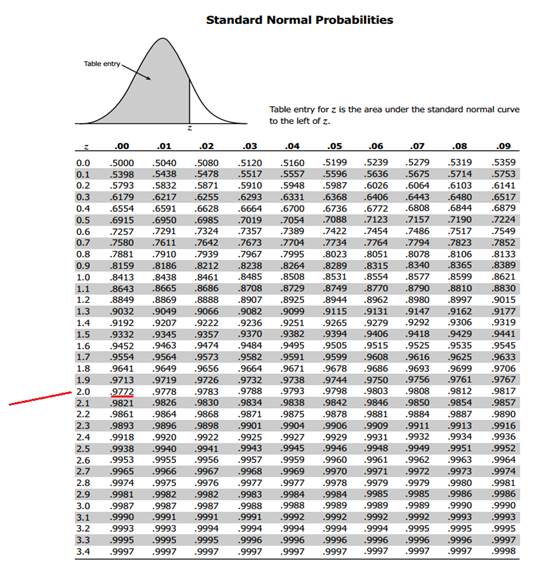
The probability of project completion in 25 months is 0.9772.
Hence, the probability that the project completion time is 25 months is 0.9772.
e)
To compute: The due date that yields a 95% chance of completion.
e)
Answer to Problem 23P
The due date that yields a 95% chance of completionis 24.2 months.
Explanation of Solution
Given information:
Calculation of due date that yields a 95% chance of completion:
The z value from the normal distribution tables as shown below,
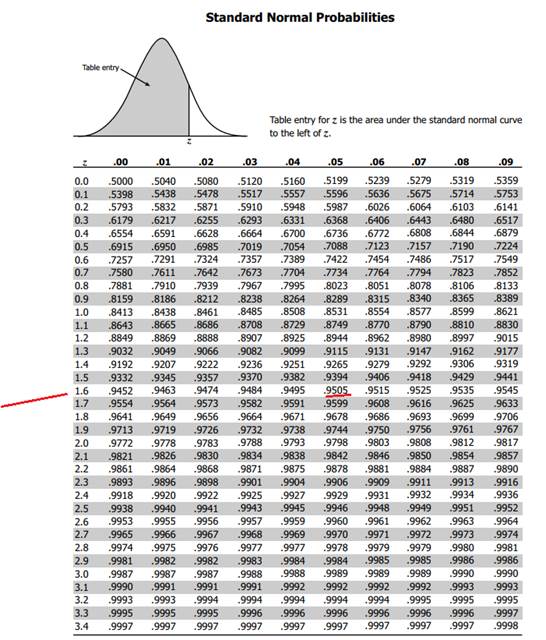
From the above tables, observe that the z value is 1.65.
Compute the due date that yields a 95% chance of completion.
The due date is calculated by adding 21 months with the product of 1.6 and 2 which yields 24.2 months.
Hence, the due date that yields a 95% chance of completion is 24.2 months.
Want to see more full solutions like this?
Chapter 3 Solutions
PRIN.OF OPERATIONS MANAGEMENT-MYOMLAB
- Scan To Pay Log into your own Lightning UPI account of supporting app and scan QR code below to pay! ✰ BINANCEarrow_forwardTo help with preparations, a couple has devised a project network to describe the activities that must be completed by their wedding date. Start A Ꭰ F B E The following table lists the activity time estimates (in weeks) for each activity. Optimistic Most Probable Activity Pessimistic A 4 5 6 B 2.5 3 3.5 C 5 6 7 D 5 5.5 9 E 5 7 9 F 2 3 4 G 7 9 11 H 5 6 13 H Finish Based only on the critical path, what is the estimated probability that the project will be completed within the given time frame? (Round your answers to four decimal places.) (a) Within 19 weeks? (b) Within 21 weeks? (c) Within 25 weeks?arrow_forwardYou may need to use the appropriate technology to answer this question. Mueller Associates is a urban planning firm that is designing a new public park in an Omaha suburb. Coordination of the architect and subcontractors will require a major effort to meet the 46-week completion date requested by the owner. The Mueller project manager prepared the following project network. B H Start A C G Finish E Estimates of the optimistic, most probable, and pessimistic times (in weeks) for the activities are as follows. Activity Optimistic Most Probable Pessimistic A 4 12 B 6 7 8 C 6 18 D 3 5 7 E 6 9 18 F 5 8 17 G 10 15 20 H 5 13 (a) Find the critical path. (Enter your answers as a comma-separated list.) (b) What is the expected project completion time (in weeks)? weeks i (c) Based only on the critical path, what is the estimated probability the project can be completed in 46 weeks as requested by the owner? (Round your answer to four decimal places.) (d) Based only on the critical path, what is…arrow_forward
- Bridge City Developers is coordinating the construction of an office complex. As part of the planning process, the company generated the following activity list. Draw a project network that can be used to assist in the scheduling of the project activities. Activity Immediate Predecessor ABC E FGH ] A, B A, B D E с с F, G, H, I A E Start B D A E Start B D H H E A E Finish Start D F J Finish Start B D F Finish Finish C H I Harrow_forwardHow can mindfulness be combined with cognitive reframing to build emotional regulation and mental flexibility? What is the strategy for maintaining mental well-being to improve through deliberate practice? How to engage in practices that help regulate emotions and build resilience?arrow_forward• We Are HIRING Salesforce Developer (2 - 4 Years) @ Cloudodyssey It Solutions Requirement : Appropriate knowledge on Salesforce standard objects Leads, Account, Contacts, Opportunity, Products, Lead process, Sales process, is required. • Hands-on experience in Salesforce Experience Cloud, Sales Cloud and Lightning. • • Hands experience with Salesforce development, administration, system integrations, Lightning Design System, and bug fixes. Experience in configuration, integration, APIs creation, testing and deployment of Salesforce.com functionality. Eloquent verbal and written communication skills. • Familiar with Agile framework. Work Location: Bangalore SUBMIT YOUR CV hello@cloudodyssey.coarrow_forward
- Agree or disagree with post On the surface, the numbers in financial statements do present a snapshot of a company's financial position and performance. However, just looking at the raw numbers often doesn't tell the whole story or reveal underlying trends and relationships that are crucial for making informed decisions. Think of it like looking at individual pieces of a puzzle. Each number is a piece, providing some information. But to see the complete picture – the company's overall financial health, its performance over time, how it compares to its peers, and its potential future – you need to assemble those pieces using different analytical tools. For example: Horizontal analysis helps us understand how specific financial statement items have changed over multiple periods. Is revenue growing? Are expenses increasing at a faster rate than sales? This reveals trends that a single year's numbers wouldn't show. Vertical analysis allows us to see the relative size of each item within…arrow_forwardWhat can you do in response to an insulting offer?arrow_forwardAgree or disagree with post If someone hits you with an insulting offer, the first thing to do is not take it personally. It’s normal to feel a little offended, but blowing up or shutting down won’t help your case. Better move is to stay calm and treat it like a misunderstanding or just the first step in the conversation. That way, you keep things respectful but still let them know the offer doesn’t sit right with you. It also helps to back up your response with facts. Bring in things like your experience, numbers, or any specific results you delivered. That can shift the conversation away from feelings and toward the value you bring. Agree or disagree with postarrow_forward
- Agree or disagree with the post When you get an insulting offer, the best thing to do is stay calm and professional. Try not to take it personally or react out of anger. Instead, ask questions to understand why the offer was so low. This helps you get a better idea of what the other person is thinking. After that, you can respond with a counteroffer that shows your value. Use simple facts like your skills, experience, and what others in your field are getting paid to back up your request. If the person still refuses to offer something fair, it’s okay to politely say no and walk away. Standing up for yourself in a respectful way shows confidence and helps others take you seriously. Agree or disagree with the postarrow_forwardRegarding perceptions that can occur when negotiating in different places and at different times, the continuation norm in e-negotiations is best described as _____. Group of answer choices A. negotiators' beliefs that negotiations are worth continuing B. the act of thinking about how things might have turned out differently C. the tendency for e-communicators to ascribe diabolical intentions to the other party D. the tendency for negotiators to behave as if they are communicating synchronously when in fact they are notarrow_forwardIn any discussion or meeting, there is a tendency for a minority of people to do most of the talking. A key determinant of who dominates the conversation is _____. Group of answer choices A. their status within the group B. their network of social connections C. their gender D. their agearrow_forward
 Practical Management ScienceOperations ManagementISBN:9781337406659Author:WINSTON, Wayne L.Publisher:Cengage,
Practical Management ScienceOperations ManagementISBN:9781337406659Author:WINSTON, Wayne L.Publisher:Cengage, Purchasing and Supply Chain ManagementOperations ManagementISBN:9781285869681Author:Robert M. Monczka, Robert B. Handfield, Larry C. Giunipero, James L. PattersonPublisher:Cengage Learning
Purchasing and Supply Chain ManagementOperations ManagementISBN:9781285869681Author:Robert M. Monczka, Robert B. Handfield, Larry C. Giunipero, James L. PattersonPublisher:Cengage Learning

